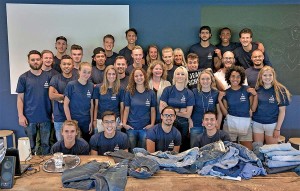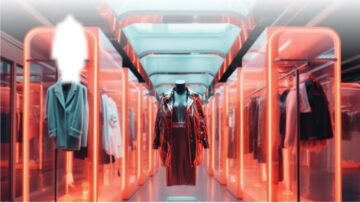
As sustainability is being brought to spotlight time and again, the industry is focussing on making sustainable products starting from the crop to the finished product, including the ever popular denim. Though sustainability in denim production is a term that the industry is gradually coming to terms with, but Amsterdam based House of Denim, a foundation to develop craftsmanship and stimulate innovation in the denim industry, is already working towards it. In conversation with Team Apparel Online, James Veenhoff and Mariette Hoitink, both Co-Founders talk about the growing need for sustainable denim production, a US $ 50 billion industry and the changes it will bring about.
According to industry estimates, producing one pair of jeans requires more than 2,500 gallons of water, nearly a pound of chemicals and vast amounts of energy. Multiply that by 2 billion – the number of jeans produced worldwide every year – and you get a snapshot of an industry that contributes a hefty share of wastewater and greenhouse gases to the environment. Today, recycled water for jeans wet processing, laser and ozone in laundry and numerous alternative raw materials and alternative sources of energy which are sustainable, are all readily available to reduce the impact of a pair of jeans on the environment. Moreover, “Sustainability to me is that the true cost and value are respected throughout the production chain, so that no damage is done without being repaired, which means environment-friendly production of cotton, fair wages and working standards, clean processes at all key steps like dyeing, laundry, etc. This implies that we as consumers also know the value of things,” reveals James Veenhoff, Co-Founder, House of Denim.

With a clear mantra of Towards a Brighter Blue, the House of Denim aims at making the denim industry cleaner, dryer and smarter through four pillars of education, research and innovation, enterprise and networking. “Through this initiative we will train a new generation of bright blue talent to be abreast of the latest development in cleaner, dryer and safer denim production and also connect and inspire key denim industry hubs from California to New York, Sao Paulo, Amsterdam, Italy, Turkey, Tunisia, India, Pakistan, China and Japan,” remarks James.
Till recently, this huge industry did not have a single dedicated school, college or university for training upcoming talent, which was later changed through House of Denim’s Jean School, the first and the only school on earth in collaboration with ROCvA, Amsterdam’s regional education council, which trains young professionals focusing on entire cycle from crop to shop. The curriculum of the school was developed with denim experts to ensure optimal fit with the industry reality. “It is a 3 year full-time vocational school that trains young talents to become ‘denim developers’. For now it’s only for Dutch students but we are currently working on an international curriculum,” informs James. The school is at the crossroads of old-fashioned craftsmanship and new concepts of sustainability in design, where students when they graduate will know the conventional trade, skills like cutting, sewing, stitching and washing, and will also learn new elements in the business.
[bleft]“It is a 3-year full-time vocational school that trains young talents to become ‘denim developers’. For now it’s only for Dutch students but we are currently working on an international curriculum.” James Veenhoff, Co-Founder[/bleft]
Along with the Jean School, the foundation also has a networking concept called ‘the Indigo Embassy’, an international networking platform, aiming to connect and inspire collaborations between players throughout the global industry. The first Indigo Embassy summit was hosted at the WLIFW 2012 in order to promote Amsterdam and Delhi as denim industry capitals.
During the summit key Dutch and Indian denim kingpins discussed the strengthening of the Dutch-Indian network, future of the denim industry and what steps can be taken towards a more sustainable denim industry.
“We got great support last year at our first Indigo Embassy summit during the Indian Fashion Week and intend to be back as soon as we have finished setting up our ‘denim institute’ in Amsterdam,” notifies Mariette Hoitink, Co-Founder, House of Denim.
[bleft]Bringing together brands such as G-Star, Tommy Hilfiger, Levi’s, Denham and Scotch and Soda, the House of Denim foundation is helpful in connecting and inspiring the industry towards cleaner innovations in denim production.[/bleft]
With a staggering 2.5 billion yards of denim being produced globally every year, its toxic-heavy manufacturing processes contribute largely to the effusion of numerous greenhouse gases. Also around 35 per cent of the world’s cotton, which is a very water intensive fibre, is used in the manufacture of denims. Not to mention the risk of tuberculosis or silicosis to workers in perfecting the ‘worn look’ during the sandblasting process; with estimates of 5,000 textile industry workers having been affected by Silicosis, a form of occupational lung disease. In order to cater to green production practices, in early 2014, the House of Denim will open its first Blue Lab, an R&D and knowledge centre for sustainable washes in Amsterdam. This facility would cater to the needs of the denim companies in the region, geared towards solving problems relating to water, chemicals and recycling. “With improved technology and chemical formulations we should amaze the world by taking the lead and how cool would it be if the denim industry got its act together and became circular,” claims James. Lastly, the House of Denim’s fourth pillar, i.e. Entrepreneurship, is an Indigo Archive, which is a museum/gallery/archive/shop for all things related to high-quality denims.
Although foundations such as the House of Denim are working towards sustainable solutions for the production of a piece of denim but there are various challenges associated with it. “There are three-fold challenges: firstly, it has to look and feel good; secondly the price must not be significantly higher than the regular denims and lastly the customer has to ‘want’ it rather than be told that it is important,” outlines James.
Incorporating sustainable measures some believe it can indefinitely increase the cost of denims, but James points out, “In the future we will have to start looking at a more circular setup, therefore it is important to find ways to close the loop from garment to garment, possibly through refibering, which is complicated and the innovation requires huge investment. But at the same time there are also great efficiencies to be found such as if indigo is recaptured from the dyeing process, it can be re-used, resulting in lower overall dyeing cost. Also, a well-insulated laundry saves money on their electricity bill and waterless laundry means lower local impact.”
At present denim has become very much a staple in the modern day lives as it’s both practical and fashionable and a good pair of jeans can live for decades. Unfortunately, its impact on the Earth isn’t quite as positive as the role it plays in our wardrobes. But innovations being an important need of the hour, initiatives such as House of Denim are constantly striving to reduce the environmental repercussions in the denim industry. Also, a few buyer-supplier alliances have emerged in recent times and are now continuously gaining momentum including Prosperity Textiles collaborating with Tencel, Clariant, Olah Inc. and Jeanologia. Nonetheless for this concept to be widely acceptable it is important for the customers to be willing to pay extra for sustainable products, which is likely if the makers attach it with a story that the customers can relate to. “We need to provide more transparency and information to the consumers, because right now it is really hard to explain the difference between two garments, even if the processes are a factor 10 apart,” understands James.
Irrespective of the increasing focus on sustainability, till date the effects of all of these innovations and cooperation is still too little. But for the jeans industry as a whole to make big steps towards more sustainable initiatives, the best way is setting common goals and an ambitious time path to get there. Nevertheless it becomes increasingly important for the entire supply chain to collaborate because individual efforts cannot provide the desired results. “Sustainable production of denims is more a joint effort rather than an individual one,” concludes Mariette.






